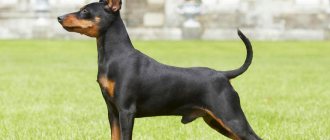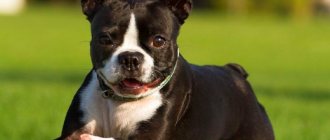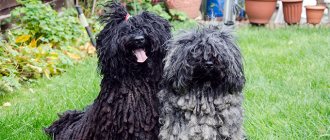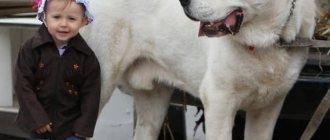A dog's temperament is a stable set of psychophysiological characteristics that underlies the formation of character and behavior. The dog's temperament is determined by the type of higher nervous activity. A dog's temperament is what it is born with and what largely determines its life. What types of dog temperament are there and how do they affect the process of training and raising a pet?
Photo: pixabay.com
What determines temperament?
In other words, temperament is a property of the nervous system
, which determines the strength, mobility and balance of nervous processes, the body’s ability to adapt. The strength of the nervous system is its resistance to prolonged exposure to a stimulus, both excitatory and inhibitory. Balance is a balance between the processes of excitation and inhibition. The mobility of the nervous system means the prevailing speed with which all nervous processes occur. Temperament serves as the biological foundation for a dog’s character and forms its basis.
It is impossible to change the type of temperament, because it is an innate property of the nervous system, and not acquired during life under the influence of environmental factors.
How can you help a stressed dog?
Dogs that are stressed or anxious will exhibit certain behaviors, which may include:
- Choking
- Excessive barking
- Aggression
- Pee or poop around the house
If your pet exhibits any of these behaviors, it is best to try to calm him down and call your veterinarian.
Today, there are drugs on the market against stress in dogs, for example, “Stop Stress”, but we strongly do not recommend using these drugs without a doctor’s prescription, since they contain the substance phenibut - if used incorrectly or excessively, it leads to serious consequences.
Since we now understand how dogs reflect human emotions, one of the best things you can do for your upset pup is to manage your own stress levels.
But reducing your own stress is not always possible. Or perhaps your dog is stressed for reasons unrelated to your mood, such as a medical illness or a change in life situation.
We recommend reading:
- How to stop a dog from eating its own poop?
- How to clean a dog's ears at home?
- Rating of dog breeds by intelligence and trainability Stanley Koren
In this case, pet experts suggest several techniques and healthy habits that can help calm a stressed dog.
According to Roth, her previous research "has found a significant association between play and low stress levels," so regular outdoor play with your dog may be a good first step to alleviating canine stress. It will also help improve your own relationship with your dog.
On a similar note, exercise is a good general recommendation for reducing stress in dogs, according to the VCA.
Try taking your dog on longer or regular walks if at all possible.
Music therapy and massage are also recommended for relieving short-term stress in dogs. Research is also currently being conducted into whether the oil, cannabidiol, can have the same calming effects on dogs as it does on humans.
But when in doubt, consult your veterinarian before trying any new treatments or regimens for your pets. Under certain circumstances, veterinarians may prescribe anti-anxiety medications for your dog.
Four types of temperament in dogs:
- strong unbalanced type - choleric;
- strong, balanced, mobile type - sanguine;
- strong balanced inert type - phlegmatic;
- weak type - melancholic.
“Pure” types of temperament are rare, but the predominance of one or another tendency is always manifested in the dog’s behavior. Be attentive to your pet, and you can easily determine what type of temperament he belongs to.
A choleric dog is a strong unbalanced type.
Choleric dogs are characterized by high nervous excitability: their excitation processes prevail over the inhibition processes, such dogs calm down slowly and with difficulty. These dogs react very quickly, often thoughtlessly, do not control their impulses well, show impatience, impetuosity, abruptness of movements, and unbridledness. These are very active, restless, sociable and very emotional dogs, real liveliest.
A restless choleric person actively reacts to the environment, he truly has tirelessness and fearlessness, and this is often the source of trouble: a dog with a choleric temperament has a poor sense of proportion, it can easily play too much and start a fight with a relative - here the owner should be on guard.
Cholerics are often very “talkative” dogs: they whine, squeak, bark, and howl a lot.
These dogs have a low level of adaptation to changing environments. It is believed that choleric dogs are dogs of an elegant and light build, however, I cannot completely agree with this, since I have quite often met well-built, stocky dogs of this type of temperament. Owners of choleric dogs need to remember that pets of this temperament should be walked a lot (after all, these dogs love walks!), provide them with enough food for the mind in the form of studying smells, exploring new hitherto unexplored territories.
Also, choleric people will enjoy a variety of fun outdoor games, games both with the owner and with other dogs, but, taking into account the characteristics of dogs of this type of temperament, you should monitor the degree of tension when your pet plays with relatives and be able to intervene in time to prevent a fight .
A sanguine dog is a strong, balanced, active type.
They are often called ideal dogs, especially in terms of working qualities. Dogs belonging to this type of temperament are characterized by strong processes of excitation and inhibition, the balance of these processes and the ability to easily and quickly switch from one process to another. Sanguine dogs are active, energetic, friendly, sociable (both towards other dogs and towards people), they are cheerful and inquisitive dogs, as a rule, they get along well with children.
Dogs of this type of temperament are not prone to frequent mood swings.
They respond vividly and excitedly to everything that attracts their attention, and are distinguished by a good ability to adapt: they quickly get used to new objects and a change of environment. Such dogs are calm, self-confident, and make good contact with humans. When meeting an unfamiliar dog, sanguine dogs are usually the first to approach to introduce themselves. On walks, they love to actively explore the surrounding area, showing their curiosity, and the owner should remember this, providing the pet with sufficient walks with the opportunity to satisfy his curiosity.
A phlegmatic dog is a strong, balanced, inert type.
Such dogs are characterized by strong processes of excitation and inhibition, their balance, but at the same time low mobility of nervous processes. Phlegmatic dogs are good-natured, calm, cautious and equanimous. These are emotionally and psychologically very stable dogs, they are docile and sedentary. The reactions of such a dog are somewhat slow and inhibited. It is believed that phlegmatic dogs are extremely “taciturn”, silent dogs (especially in comparison with choleric dogs), whine infrequently, and bark even less often.
Dogs of this type of temperament are quite independent and self-confident. The advantages of phlegmatic people are that these dogs have a balanced psyche and the ability to withstand heavy loads. They are quite calm about loud sound stimuli, unlike melancholic people, who can be horrified by any loud sound.
Although it is difficult to motivate a phlegmatic person to be active, if you succeed, the dog can show itself to be quite energetic and playful, it just needs to play out properly.
And it is periodically necessary to stir up phlegmatic people, for their own well-being. The fact is that with age, phlegmatic people become even lazier, so it is necessary to provide the pet with the necessary physical activity in order to avoid health problems, including obesity, to which such dogs are prone. At the same time, it will be great if the owner gives the phlegm pet the opportunity during a walk to simply lie quietly in the shade under a bush or soak up the grass, exposing his back to the warm rays of the sun - the dog will be very grateful to you for this, believe me. And this will benefit the animal.
A melancholic dog is a weak type.
Dogs with a melancholic temperament are characterized by weak excitation processes and easily occurring inhibitory reactions. They have increased sensitivity and emotionality. A melancholic dog is a timid, indecisive, insecure dog, very vulnerable and rather sedentary, affectionate. Such dogs have poor ability to adapt; they have difficulty getting used to new things. Melancholic people do not tolerate loneliness well, whine and howl when left alone. It is very characteristic that in dogs belonging to this type, passive-defensive reactions predominate: tail between their legs, grinning, defensive lunges. When meeting other dogs, they tuck their tail between their legs and do not like to be sniffed from behind.
Melancholic people whine more often than bark. They have increased sensitivity even to weak stimuli, not to mention strong ones; these are dogs of a very gentle temperament.
Also, such dogs quickly and easily react to prohibitions. With melancholic dogs you need to be especially affectionate, attentive to them and very patient. I would like to wish patience, patience and more patience to all owners of melancholic people; we cannot do without it. What you can afford when communicating with a sanguine, choleric or phlegmatic person is not suitable for a melancholic person. Patience when dealing with a melancholic dog is a key quality. Often, owners of dogs belonging to other types of temperament fail to understand the owners of melancholic dogs: why is he bothering with her so much? I can understand them, but until you experience them, you won’t understand).
Under no circumstances should you raise your voice at such a dog - this can aggravate its condition and make it even more insecure and timid; physical punishment (even if it is “just” a symbolic spanking with a newspaper) is strictly prohibited. At the same time, one should not think that such a dog’s temperament is a “sentence” for an active owner. It is quite possible to stir up a melancholic person, and this will be useful, first of all, for himself: if it is enough to walk such a dog, enrich its experience by learning new things, introduce it to the environment, then it is quite possible that the dog will overcome its fear and become a little more sociable and a little more active. Although, of course, one cannot expect from her the activity of a choleric person and the sociability of a sanguine person, a melancholic dog is a creature of a completely different cloth. They are also very wary of strangers.
How does human stress affect dogs?
Researchers have known for years that human stress can negatively impact pet dogs.
Roth's own research has shown that dogs tend to mirror the emotions of their human owners.
“We hypothesize that dogs largely reflect the stress levels of their owners,” Roth's team wrote in a previous study.
They found that herding dogs in particular synchronize their long-term stress levels with those of their owners. More recent research by Roth describes this connection between human stress and dogs as “emotional contagion.”
Because dogs mirror human emotions, our emotional stability—or lack thereof—can significantly impact our furry friends.
One study found that dog owners with higher levels of agreeableness also had higher levels of variability in the stress hormone cortisol, which indicates greater emotional stability. The opposite was found for owners with greater degrees of neuroticism.
Another study of dogs found that puppies performed worse on tasks when their humans scored higher on a measure of “neurotic” traits on the Big Five test. Conversely, Roth's previous research found lower levels of stress in dogs whose humans scored higher on “conscientiousness” and “openness.”
Finally, recent research by Roth suggests that “stress-related human personality traits, such as fear and aggression, influence” dog stress.
Learning to read a dog's mood
South African Boerboel
Another brave guard with calm and self-confidence. The Boer Mastiff, as these dogs are also called, is phlegmatic. However, the animals have proven themselves to be excellent guards. Heavy, massive, with a wide head and an unkind look, the Boerboel makes an intimidating impression. There is simply no need to be afraid of a Boerboel; the dog is unlikely to attack without a command. But trying to get to know him is too bold a decision. However, few people want to meet a dog weighing 90 kg.
The Boerboel is ideal for guarding and living in a private home. A large, serious, phlegmatic dog needs serious training with a dog handler.
Bloodhound
A beautiful big hound, a good hunter and just a wonderful friend. Bloodhounds are very smart dogs, but they are very stubborn and difficult to train, so it is not worth getting them for protection. But this breed of dog will serve its beloved owner with great pleasure. This is not the fastest of hounds, but its low speed is fully compensated by its keen sense of smell, intelligence and perseverance in achieving its goal. Bloodhounds treat other pets (including cats) well and are usually friendly with them.
It is worth noting that Bloodhounds are recognized as the most intelligent dog in the world.
American Akita
The main character traits of the American Akita are loyalty to the owner and independence. This dog will never lose its dignity; it has confident movements, a proud gait and a bold look. He is patient with children, but will not allow himself to be pulled by the tail and ears for a long time. An Akita cannot be called a good nanny, but the dog behaves very friendly with other pets, but at the same time strives to dominate.
The American Akita cannot tolerate the smell of alcohol and can behave unpredictably around drunk people.
Italian Cane Corso
When meeting a Cane Corso, there is a desire to cross to the other side of the street. The representative of the breed makes too formidable an impression. Stocky, massive, with a piercing gaze - real monsters.
Few people know that under the frightening appearance hides a real phlegmatic person. Cane Corsos seem to be slow and indifferent dogs. So it is, only for the time being. Animals are excellent guards; in an emergency, they can suddenly turn on and give the enemy a “dark”.
A breed for people who are able to physically and mentally cope with a large pet bred as a guard.
Pug
Historically, this dog breed is considered a companion pet. They tolerate loneliness well and patiently wait for their owner to return from work. Pugs are friendly and cheerful dogs with little physical activity, so they are quite happy with short walks. They can be trained well, but do not have protective qualities. Pugs become very attached to their owner and expect reciprocity from him; they love to sleep with him in his arms.
English bulldog
An ideal dog for a family. He feels great in a big company, is friends with children and pets, but only if they do not show aggression towards the bulldog. The boxer does not need serious physical activity, so the owner does not have to walk the pet for a long time. A calm and very balanced breed that practically nothing can upset. A slow dog that will not get into trouble or fight for the palm. But they sense aggression from other people well, and also recognize the danger to the owner and then can behave quite aggressively.
Dogue de Bordeaux
This breed is otherwise called French Mastiffs, as they are descendants of Molossians and Alans. The menacing and aggressive appearance of the dog absolutely does not correspond to the character of the dog. Bordeaux are sociable and very peaceful; they are distinguished by an extremely calm disposition and devotion to their owner.
The positive character traits of Bordeaux are:
- communication skills;
- peacefulness;
- devotion;
- equilibrium;
- intelligence;
- intuition;
- responsibility;
- courage without aggression.
As for negative qualities, Bordeaux are touchy. If the owner undeservedly scolds the dog, beats it and screams, it will stop trusting the owner, will be afraid of him and will remember the insult for a long time. Bordeaux dogs love and protect children and pets.
Who is I.P. Pavlov?
Outstanding Russian scientist
Ivan Petrovich Pavlov is a famous Russian physiologist and scientist. He founded the physiological school and became the first Russian to receive the Nobel Prize.
The scientist gained fame thanks to his discoveries. Namely, the discovery of the conditioned reflex and the creation of the science of higher nervous activity.
In addition, Ivan Petrovich made numerous discoveries in the field of physiology of blood circulation and digestion. Scientific activity mainly took place in St. Petersburg.
Newfoundland
A large, affectionate dog that looks like a bear. These shaggy giants are distinguished by their good disposition, they have absolutely no aggression, so getting such a dog for protection is completely futile. The Newfoundland's calling is to take care of people and help them in emergency situations. For such a dog to growl or bite is nonsense. They respond well to training, but will not tolerate rude and tactless attitudes towards themselves.
These are unique dogs - they love people so much that they are ready to get acquainted with all passersby who pay attention to them. And they are very surprised why the stranger froze in horror when the dog rushed to lick him from head to toe.
Shar Pei
The Shar Pei is independent, loyal and very active. The behavior of the dog depends on the character of the owner - he accepts the characteristics of the person he trusts and adapts to him. That is, the dog is ready to rejoice or be sad with the owner who loves him. This breed of dog will not dominate others and will not conflict with either animals or people. Completely unsuited to a fighting career.
The main thing that the owner of a Shar Pei must learn is that a dog of this breed should never be beaten, otherwise an intelligent and good-natured animal will turn into a frightened and withdrawn one. He behaves friendly and very kindly with children, the Shar Pei himself will refuse their careless games, and is also calm and peaceful towards small breeds of dogs and cats.
Basset Hound
Long ears, an elongated body and a smile from ear to ear. Description of a typical basset hound living in a city apartment. You probably won’t find a greater phlegmatic person in the world. When a Basset goes for a walk, all the children in the area come running to him, and the adults smile. Representatives of the breed simply love to hug, kiss, and are happy to expose their belly for scratching. And all this with absolute calm. The only drawback of the “tricolored dachshund” is that its appearance is not for everyone.










